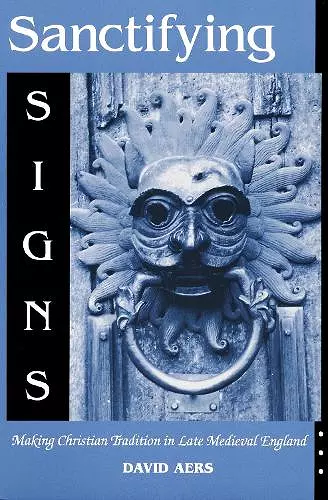Sanctifying Signs
Making Christian Tradition in Late Medieval England
Format:Paperback
Publisher:University of Notre Dame Press
Published:30th Apr '04
Currently unavailable, and unfortunately no date known when it will be back
This paperback is available in another edition too:
- Hardback£86.00(9780268020217)

Concentrating on the sacrament of the altar, poverty, and conflicting versions of sanctity, Sanctifying Signs presents a critical study of Christian literature, theology, and culture in late medieval England. In this notable book, David Aers considers the diverse ways in which certain late medieval Christians and their Church engaged the immense resources of the Christian tradition in their own historical moment. Using a wide range of texts, Aers explores the complex theological, institutional, and political processes that shape and preserve tradition during changing circumstances. He is particularly interested in why some texts were judged by the late medieval Church to be orthodox and others heretical, and the effect of these judgments on the conversations and debates of the fourteenth and fifteenth centuries.
Sanctifying Signs begins with accounts of the sacrament of the altar that were deemed orthodox in the late medieval Church. Aers then shifts his focus to the relationship between sanctification and the sign of poverty. Finally, he reflects on the relationship between some versions of domesticity and sanctification. Texts of William Langland, John Wyclif, Walter Brut, William Thorpe, and others are examined within the context of a broad range of earlier and contemporary writings and events. Through these modes of exploration Aers seeks to understand and reinvigorate a theological, ethical, ecclesiological, and political conversation that has been pursued through a variety of rhetorical forms since the late Middle Ages.
“This book is a literary study of some important Middle English texts, treating them as theological statements emanating from the fourteenth and fifteenth centuries. . . for those interested in the intersection between religion and literature, this book will provide a great stimulus to fresh thinking on a theme that continually resurfaces in European, as well as in English culture.” —Sobornost
“ . . . this provocative study explores the converging and diverging currents of orthodox and heterodox, or authorized and dissenting, or institutional and lay religion in late medieval England. . . . Aers's impressive expertise in various aspects (institutional, political, theological) on late medieval religion, emerging in diverse contexts (monastic, mendicant, lay, Wycliffite), affords him a multifaceted perspective.” —Religious Studies Review
"English and Latin texts by William Langland, Nicholas Love, John Wyclif, Walter Brut, William Thorpe, and others are thus read, not through modern literary and political theorists, but through the Gospels, Aquinas's Summa theologica, and several contemporary theologians, especially Rowan Williams. Aers seeks to explore how theological controversies around several important late-medieval signs (the Eucharist; the sign of poverty; the house) were conducted in a range of academic and vernacular texts and how all participants in these controversies viewed the relation between theological theory and sociopolitical practice.” —Journal of English and Germanic Philology
"As the title suggests, Sanctifying Signs is a study of both the power of signs to awaken holiness-'sanctifying' as a participle-and the processes by which signs come to be revered within a faith community-'sanctifying' as a gerund. Specifically, the book deals with the Eucharist, poverty, and home, and how these signs became venues in the large struggle within English Catholicism in late medieval England." —Christianity and Literature
"David Aers has written another rich and provocative book in his ongoing exploration of religion's socially and politically constitutive role in late-fourteenth- and early-fifteenth-century England. . . . Aers takes care not to conflate Langlandian and Wycliffite perspectives but rather to show the aberrant singularity of what in Arundel's church passed for orthodoxy. Tacitly ranged against its version of the Body of Christ are other, more biblical understandings whose diversity, complexity, and wealth Aers continues to teach us." —Speculum
"David Aers's latest volume of intricately argued polemical essays concerns the contribution of texts to 'processes of tradition formation, reformation, and preservation' in late medieval English Christianity. . . Sanctifying Signs, merciless towards the 'exorbitance' of doctrines enforced at the time by the ecclesiastical hierarchy but also alert for paradoxes and divergences in the reformist position, will certainly claim a place in the burgeoning investigation of late medieval constructions of the Church." —MLR
"David Aers' latest book makes a significant contribution to the dialogue about the significance of alternative versions of Christian doctrine and practice in late medieval England. . . Beyond its medieval subject matter, Aers's book questions the relationship of critical reading to theological assumptions." —The Sixteenth Century Journal
"Aers's close readings of a variety of prominent and less-known medieval texts make this a valuable interdisciplinary study. Recommended." —Choice
“. . . incisive examination of late medieval religious beliefs and practices and their representations in and development by late fourteenth- and early fifteenth-century English textuality. In both scope and depth this well-written inquiry will interest many medievalists studying late medieval theology and social and religious history.” —The Catholic Historical Review
"David Aers's latest book makes a significant contribution to the dialogue about the significance of alternative versions of Christian doctrine and practice in late medieval England. Aers's grasp of these issues is impressive, and his detailed reading of the seemingly contradictory treatment of poverty in the C-version of Piers Plowman not only serves as a valuable extended annotation but may be read (and assigned) separately. . . I highly recommend this chapter as well as the rest of Sanctifying Signs. His approach should succeed to the degree that the reader cares, as Aers obviously does, about the ongoing relevance of the institutions and practices intelligent people died (and killed) to define and defend six centuries ago." —Sixteenth Century Journal
ISBN: 9780268020224
Dimensions: 229mm x 152mm x 16mm
Weight: unknown
296 pages